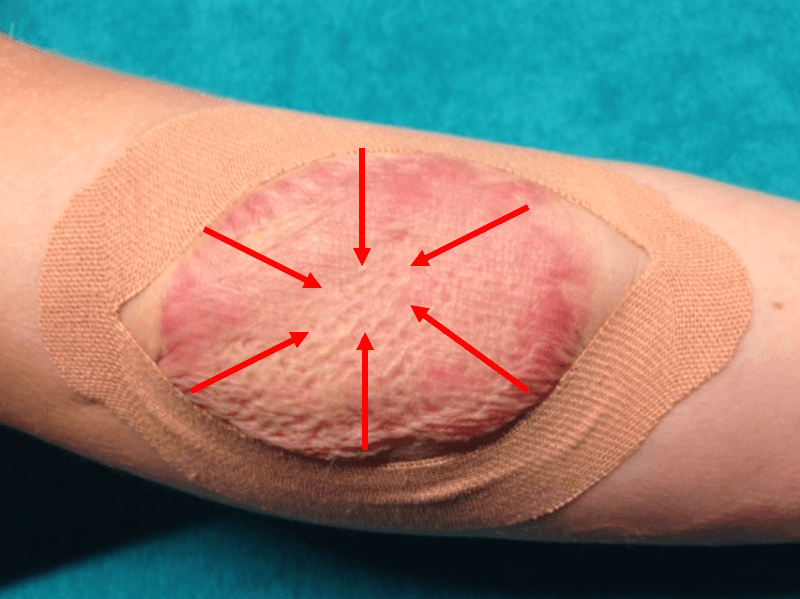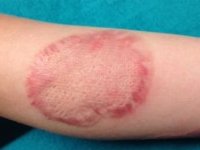CureTape® Kinesiology tape appears to have a beneficial effect on Hypertrophic scars when applied with this specific technique.
What are hypertrophic scars?
In thick scars, an excess of collagen fibres has developed during wound healing. The scar rises above the skin level. The wound is thickened, red, may be itchy, has increased tissue tension and may also feel painful. Burns are examples of hypertrophic tissue.
OSCARE study: the effect of CureTape on thickened scar tissue
The effects of elastic therapeutic tape on hypertrophic scars: a cohort study.
Peter Moortgat, OSCARE, Belgium – 7 December 2020
Download the full study on medical taping for hypertrophic scars.
The main objective of this study was to investigate the influence of CureTape in the treatment of hypertrophic scars.
The effects of CureTape on:
- The colour of the skin and the scar
- The transepidermal water loss (moisture loss from the skin)
- Stretchiness and elasticity of the skin
- Thickness of the scar
- Hydration (moisture absorption) of the scar
- Itching
Tapestry technology chosen by OSCARE for this study
In all phases of the project, the elastic therapeutic CureTape is applied in the same way: a notch is made in the middle of the tape, lengthwise. Do not cut the anchors when doing this. Then, the tape is applied around the scar tissue, but the tape does not make contact with the scar tissue. The tape is worn for 2 days, then removed to allow the skin to rest (at least 24 hours). A new tape is then applied.

Results
In this study, a statistically significant improvement was measured in terms of itching, skin thickness, colour and elasticity.
CureTape® appears to have a beneficial effect on scars when applied with this specific technique. It is recommended that a further randomized controlled trial (RCT) be conducted to confirm the results of this cohort study.

Background information on wound healing and scars
Wound healing can be divided into 3 phases:
- Inflammation phase: 1-4 days.
Wound healing, scar tissue with collagen fibres is produced. - Recovery phase (regeneration phase): 4 days – 3 weeks.
New tissue is formed. - Maturation phase: from 3 weeks.
In this phase, a balance between production and degradation of collagen fibres occurs.
When the wound healing process is disturbed, scarring problems arise.
Disruptions can be: infection, poor general condition, poor circulation, location on the body, age of the client.
Fibroblasts are the most important cells of the connective tissue, they produce collagen fibres. Collagen fibres are non-stretchable fibres that provide strength. Fibroblasts also play a role in wound healing. They can transform into myofibroblasts, which seal the wound and are responsible for the production of scar tissue consisting mainly of collagen fibres.
Which scar treatment techniques are there within the Kinesiology taping Concept?
Within the Medical TapingKinesiology taping Concept, various taping techniques and possibilities are known for taping scars and treating oedema and lymphatic problems. Are you, as a health professional, interested in these techniques, please have a look at the new manual by David Blow, NMT Taping of Edemas, Hematomes and Scars.
This is a very comprehensive, rehabilitation-oriented handbook on various drainage options for oedema, haematoma and scars. Supported by many practical examples.
More information:
- Request a CureTape® sample pack for free »
- Continue reading about CureTape kinesiology tape and it’s effectiveness »
- Browse through the CureTape products in our webshop »
- Continue reading about kinesiology taping instructions »
Please note that applications provided on our website are not clinically proven. All mentioned applications are based on extensive evaluation and case studies with licensed physiotherapists and/or other health professionals.
Attention: Mentioning source is mandatory, when using the content on this page.

